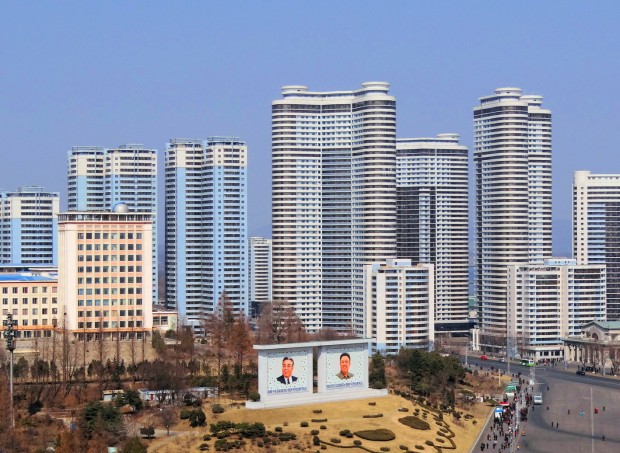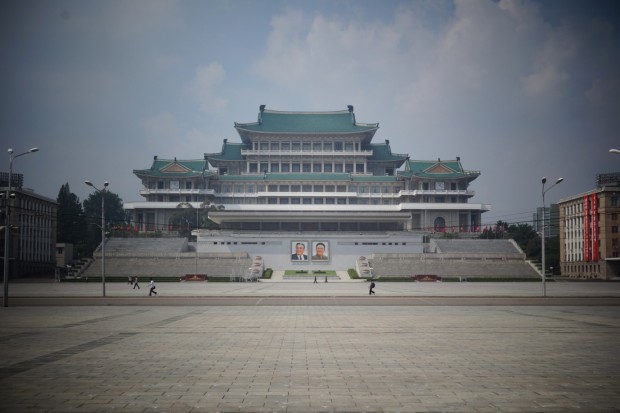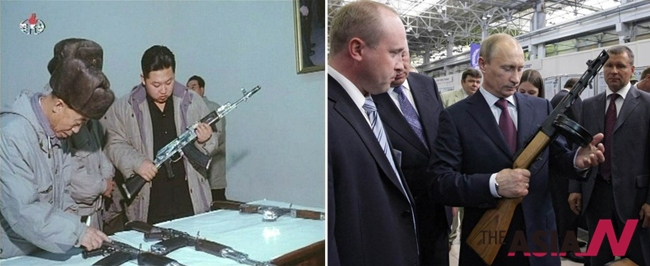
Pyongyang, from “Revolutionary Capital” to “Carnal City”

By Joel Lee
Neon-lit, high-rise apartments smack in the middle of the city center. Light-industrial factories inside apartment complexes. A chessboard of a vast, empty square in downtown. Urban greenery of grass and park. Murals of blue and red resembling a fighting scene of a cartoon.
These rare images, only imaginable in the “capitalist city” of Seoul, are in fact everyday landscapes of the “socialist city” of Pyongyang. German architect Philipp Meuser, in his book “Architectural and Cultural Guide: Pyongyang,” described the socialist capital as: an “experimental city under strict surveillance where all life is neatly compartmentalized”; and an “outdoor museum that has most pristinely preserved the socialist style of its architecture.”
“Those who have visited the city remarked of a kind of ‘chilling perfection’ in its landscape, peculiar to the eyes only accustomed to seeing cities in democratic countries,” he added.
“An urban planner is a dictator,” an adage goes, denoting the inseparability of power and building. From Hitler’s Berlin to Ceausescu’s Bucharest, history is full of “Sim Cities” that have fallen prey to their masters’ vainglory.
Pyongyang is no exception to the rule. It is a window and mirror into the Hermit Kingdom and the autocratic Kim family. As a never-ending Utopian experiment, Pyongyang was built on the ruins of the Korea War to realize the socialist ideology of equality. In North Korea where market economy does not officially exist, the city is run by the central planning of the communist bureaucracy.
North Korean cities are organized along the street as opposed to the town as in South Korea. High-rise apartments in tints of grey and pastel line up the major arterial roads of Pyongyang, glorifying the socialist architecture as well as hiding the abject poverty that lies behind. There are bellicose propaganda posters and slogans located in strategic spots across the city.
The 2.5 million Pyongyang residents are the “upper and middle classes” in North Korea. Five hundred thousand of them are the regime’s core elites. The government strictly controls the right of residence and access in and out of the city.
But recently, Pyongyang is under a “gentle breeze of bourgeois changes” commodifying the urban landscapes steeped in socialist-nationalist legacies. Under leader Kim Jong-un’s orders, scores of luxury cars, colorful taxis, European coffee shops, fast-food joints, shopping malls and entertainment facilities are springing up across the planned city.
Pyongyang’s apartments, virtually the only form of dwelling units, lie at the center of the marketization of society and polity, leading to phenomena commonly observed in capitalist cities, such as “property speculation” and “bubbles.”
According to insiders, there are now more apartments that are built by the individual government branches for the strict purpose of sale, and there are more people buying the units than those being allocated through the government; according to Professor Andrei Lankov of Kookmin University, the housing market is “completely dollarized.” The interior and furnishing industries are also booming.
The construction boom is leading to rampant corruption and cronyism across the state departments, so pervasive that it threatens the regime’s survival.
But the sewerage, hydro and water infrastructures are far outdated, with Pyongyangers sleeping through the biting North Korean winters wearing layers of scanty long johns and clasping heated water bottles. The scarce electricity and lack of elevators make the lower floors more prized than the higher floors, the opposite of South Korea where looking down from floors up high has become the treasured leisure of the rich and the powerful.
The communist virtue of doing everything as fast as possible is fervently exercised in construction, where assembling and building an apartment unit made of prefabricated units every 14 minutes has led to the catchphrase – the “Pyongyang Speed.” Experts say the heedless, headlong approach to efficiency has created fatal structural flaws in the built units, undermining safety. The collapse of a high-rise apartment building in the Pyongchon district of Pyongyang last May, where more than 300 residents reportedly have died, was also the result of such boasted-yet-ineffective efficiency, experts say.

Pyongyang after unification – a Capitalist City
Experts say the privileged status of Pyongyang from the rest of the country will be reversed after national unification, as the forces of market economy will bring prosperity to the smaller cities, particularly those along the Chinese border.
“There is currently a ‘bifurcation’ of economy taking place inside North Korea, with the market encroaching on the official planned economy. There will be devolution and decentralization of power,” they said.
The “socialist city” of Pyongyang is currently experiencing a host of problems of residential stratification, social exclusion and industrial blight, making obsolete its raison d’etre as the champion of balanced development. Academics say the troubles stem from the “systemic dilemma of socialist production and distribution” itself.
Urban planners stressed the importance of city planning after the national unification during which the nationalized properties and assets will be privatized.
“North Koreans will be more interested in practical matters of prosperity and life’s well-being than the dusted socialist ideology,” Professor Choi Mack-joong of Seoul National University said, while emphasizing the importance of gradual privatization of land. Initially acknowledging the possessory right to land and slowly transferring it to ownership right can vitalize the economy as well as prevent large-scale migration of people to South Korea, he said.
Other experts said, following the relaxation of migration policy, legions of rural North Koreans will flock to the capital in search of jobs, activating a large-scale urbanization and inevitably boosting the demand for housing and constructions.
But the bulk of Pyongyang’s apartments being built during the industrial heydays of the 1970s and 80s, massive rebuilding and redevelopment will be needed – both in and out of the city, such as in a newly created satellite city.
The effort of South Korean government and companies, as well as the foreign firms, should be channeled into assisting the market-friendly North Korean power elites for revamping the economy, experts said. They also emphasized the need for securing large numbers of welfare housing for the poor.
Scholars said efforts must be made in preserving historical buildings and cultural assets, despite them being the remnants of failed communism. The Kim Il-sung Square, a vast open space in the heart of Pyongyang, and the public edifices surrounding it, will be open to the forces of the capital, which will transform them into spaces of consumption.
Professor Byeon Chang-heum of Sejong University said, for Pyongyang to be reborn into a “city of life” from a “city of taxidermy,” it will be vital to eliminate barriers that block communications between the residents. Thawing the icy South-North relations through academic seminars, architectural exchanges and local government partnerships can only facilitate the process, he said.
Just as the City of Gwangju became synonymous with human rights through the 5.18 Democratization Movement in 1980, and Hiroshima came to commemorate peace after being incinerated by an atomic bomb in 1945, so can Pyongyang embark on a path toward democracy after decades suffering from the brutal Stalinist tyranny, he added. Academics overall suggested nurturing the “sustainable capitalist city” of Pyongyang through participatory democracy, social economy and environmental protection.



